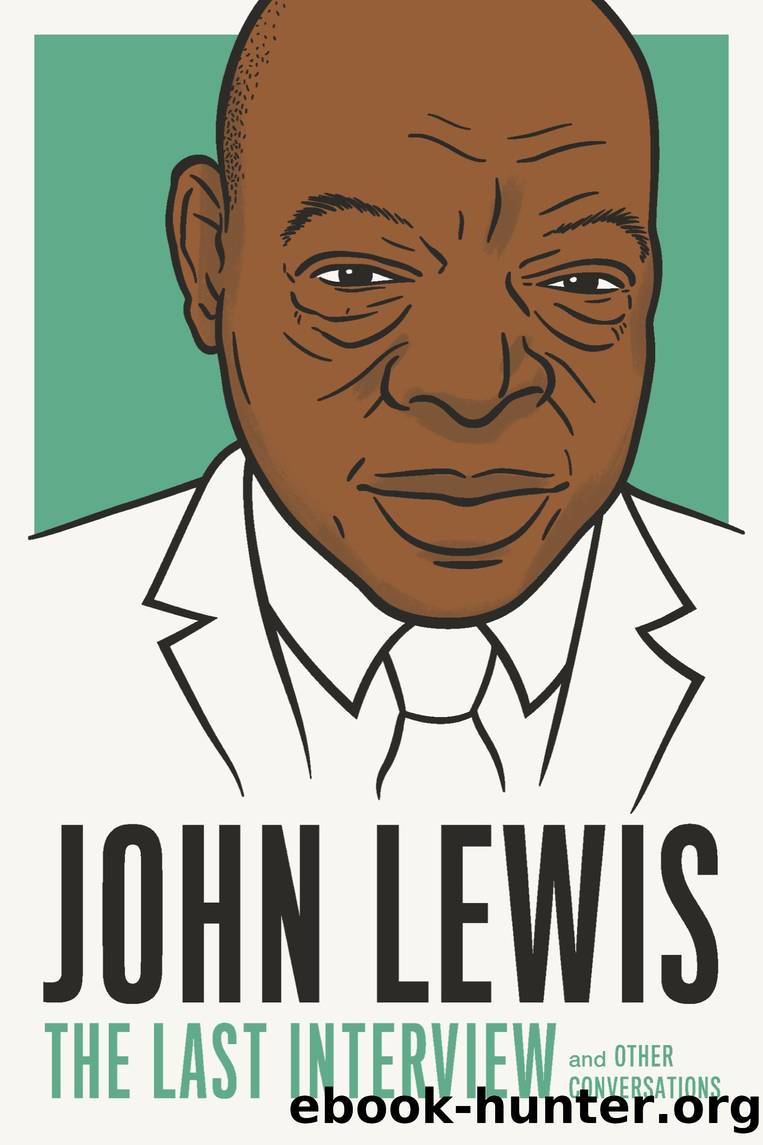John Lewis: the Last Interview by MELVILLE HOUSE & Jelani Cobb

Author:MELVILLE HOUSE & Jelani Cobb [Lewis, John & Cobb, Jelani]
Language: eng
Format: epub
Publisher: Melville House
Published: 2021-11-23T00:00:00+00:00
âWHEN I WAS ARRESTED, I FELT FREEâ
INTERVIEW BY BRIAN LAMB
C-SPAN
JULY 11, 2012
BRIAN LAMB: Congressman John Lewis, why did you name your book Across that Bridge?
REP. JOHN LEWIS: Well, during the past few years, Iâve been crossing bridges, rivers, many bridges, bridges of understanding, building bridges, trying to bring people together to create what I like to call the beloved community.
LAMB: Where does the Edmund Pettus Bridge come into that picture?
LEWIS: Well, the Edmund Pettus Bridge is symbolic of so many bridges, but in 1965, when I was much younger, and head of an organization called the Student Nonviolent Coordinating Committee, a group of young people, students, and others attempted to cross the Edmund Pettus Bridge in Selma, Alabama, to march fifty miles from Selma to Montgomery to dramatize to the nation and to the world that people wanted simply to register to vote. We were walking in twos. And when we arrive at the apex of the bridge down below, we saw a sea of blue, Alabama state troopers. And we continued to walk.
And we came within hearing distance of the state troopers. And a man identified himself and said, âIâm Major John Cloud of the Alabama state troopers. This is an unlawful march. And it will not be allowed to continue.â And one of the young people walking beside me said, âMajor, give us a moment to kneel and pray.â And the major said, âTroopers advance.â And they came toward us, beating us with nightsticks and bullwhips, trampling us with horses, and releasing the tear gas.
At the foot of that bridge, I was beaten. I thought I was going to die. I thought I saw death. So at the foot of that bridge, I gave a little blood to make it possible for all people to be able to participate in a democratic process. So the book, it just a symbolic bridge of many bridges that we still must cross, rivers that we still must cross, before we build a beloved community, a truly democratic, multiracial society in America.
LAMB: Did you ever look up who Edmund Pettus was?
LEWIS: I did look up and discover this man, Edmund Pettus, a general in Alabama. You know, the bridge, this particular bridge, was dedicated the same year that I was born, in 1940. So I have a kinship to this bridge. And every year, sometime more than once a year, but every year, I make it a point to go back to that bridge and cross that bridge. And for the past forty-seven years, Iâve gone back the weekendâthe first weekend in Marchâsince 1965.
LAMB: How did it fit in with everything that was going on back in the sixties?
LEWIS: In order to travel from Montgomery to Selma, you had to cross that bridge. You had to cross the Alabama River. Selma was in the heart of the Black Belt of Alabama. Thatâs where hundreds and thousands of poor, Black people lived. They had been sharecroppers. They had been tenant farmers.
But this little town, Selma, was a place of commerce.
Download
This site does not store any files on its server. We only index and link to content provided by other sites. Please contact the content providers to delete copyright contents if any and email us, we'll remove relevant links or contents immediately.
Anka's Secret: An epic, heartbreaking, and powerful World War 2 novel based on true events by Tamar Ohrenstein(265)
American Seoul by Rho Helena(199)
Vice President Kamala Harris by Malaika Adero(192)
Owner of a Lonely Heart by Beth Nguyen(157)
Persephone's Children by Rowan McCandless(146)
The Life of Madie Hall Xuma by Wanda A. Hendricks(136)
The Survivor From Block 19 by Arie Blumenfeld(131)
Girl Uprooted: A Memoir by Lena Lee(128)
From Liberty To Magnolia by Janice Ellis(126)
Women Surviving Apartheid's Prisons by Shanthini Naidoo Donna Bryson(123)
634 Ways to Kill Fidel by Fabian Escalante(116)
A Hole In the Clouds by Maryles Casto(113)
Growing Out by Barbara Blake Hannah(112)
My Childhood's Days in Slavery by Annie L. Burton(110)
Black Founder by Stacy Spikes(109)
Remembering the Power of Words by Unknown(105)
Truths and Lies in the Middle East by Eric Rouleau Martin Makinson(105)
Pride of Family by Carole Ione(102)
The God of No Good by Sita Walker(99)
